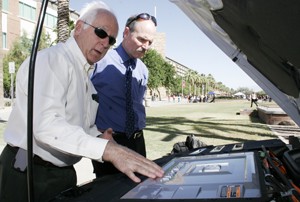With gas prices rising and the economy in a downward spiral, Byron McCormick may have a seemingly simple solution to what has become a worldwide crisis.
McCormick, a multiple-degree graduate of the UA who went on to become the executive director of fuel cell activities at General Motors Corporation advised UA students on Monday afternoon on the “”New DNA of the Automobile.””
Two hydrogen model cars stood on the UA Mall as a display of the automobile industry’s future – new hydrogen fuel cell technology.
McCormick started his quest to create a fuel-efficient vehicle as a UA student concerned about rising gas prices. He quickly realized then that his lifestyle of fuel consumption was no longer an option for him, or for car owners anywhere, he said.
“”As a leader in the development of these new hydrogen cars, the University of Arizona has served as an excellent academic platform for me, and I am still proud to be a Wildcat,”” McCormick said.
A positive attitude and open communication are integral parts of the national search for viable alternative fuels, he added.
“”You have the thought leaders, current and future, of the country and the world. People are going to be really open and perceptive to this technology,”” said Pete Barkey, GM manager of communications for Fuel Cell, Hydrogen and Electrical Infrastructure. “”This is not just about the new technology; it is about a societal change. We are held hostage to one form of energy – petroleum.””
The struggle to continue the fight for fuel-efficient vehicles lies in understanding the differences between old and new DNA of the automobile, McCormick said.
While the new DNA is electrically driven and energized by environmentally-friendly hydrogen, the old DNA relies on an internal combustion engine, is controlled mechanically and is energized by petroleum.
McCormick said that what people and even countries most desire are fuel and energy options. For instance, France is most likely to use nuclear power because of the resources they already have, whereas in the Midwest of the U.S., wind power would be most efficient.
He explained that although most people tend to favor renewable energy like solar or wind, the hidden problem is the lack of an efficient way to store them, and the distribution ability is very limited.
Ethanol, McCormick explained, is a viable option, but only if it is not shortchanging the public of food. General Motors has invested in two companies – Coskata and Mascoma – that endorse ethanol use but only cellulosic, or non-edible products in order to make ethanol.
For every one kilogram of hydrogen produced, one gallon of gasoline is used.
McCormick mentioned that hydrogen is already competitive with petroleum prices and is more efficient both for the range of the car and the safety of the environment.
McCormick said that the technology for producing the cars, which has not even been released to the market, is already six years old. And yet a prototype known as “”the Equinox”” is still more fuel-efficient than most cars. The technology has been refined, but the reasons for the cars still not being released rest in public and economic policy.
The country needs government policies that support the sustainability and accessibility of these vehicles. More hydrogen fueling stations need to be built in order for the cars to even be a plausible option for consumers, McCormick said.
“”The next president and his policies are going to determine a lot of the future of these vehicles,”” McCormick said. “”We (GM) are willing to put in the money and the technology, but we really need favorable government policies. These cars are going to be more expensive, and tax breaks would encourage consumption by the public.””
The cars, not even on the market yet, are being tested in Los Angeles and the New York-Washington, D.C. area, where there is access to hydrogen fueling stations. Through GM’s Project Driveway, the cars have been given to both regular citizens and celebrities, such as Jay Leno.
McCormick explained that it is more effective for the cars to be tested in city settings, because sitting in a lab is only so useful. Some of the heat tests for the cars were actually done in Tucson, both on desert terrain and on Mount Lemmon.
Because each car is on the market for 12 to 14 years, the new cars need to start circulation in order to be effective. Japan, Germany and the U.S. have all set a goal of 2015 to have these projects underway and available to the public, he said.
In other words, the technology is here – the public just needs to find the desire to utilize it, McCormick said.
The event was co-sponsored by the Eller College of Management, the College of Engineering and the College of Sciences in an effort to take a proactive stance on educating college students about the future of green vehicles.
“”These new models will become a very important aspect of sustainability,”” said Peter Brown, Engineering Experiment Station editor.









